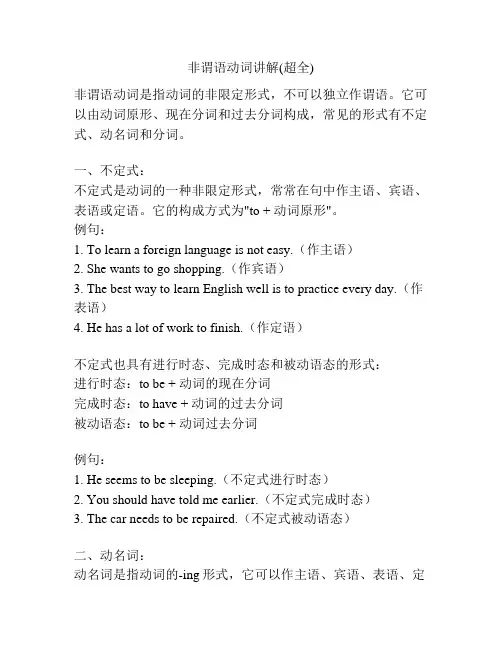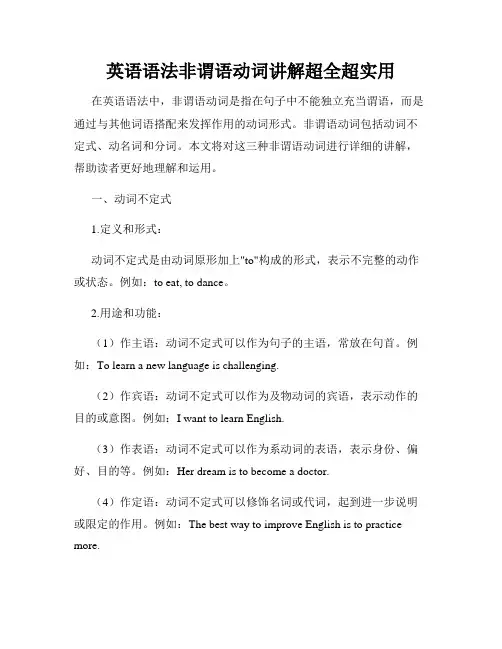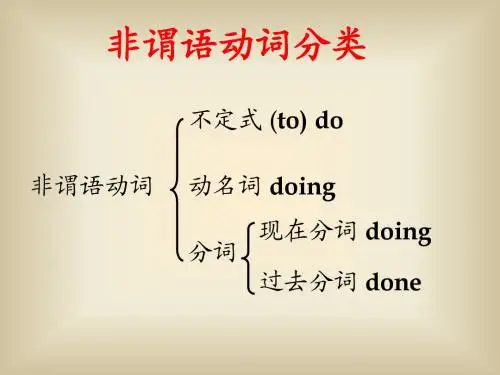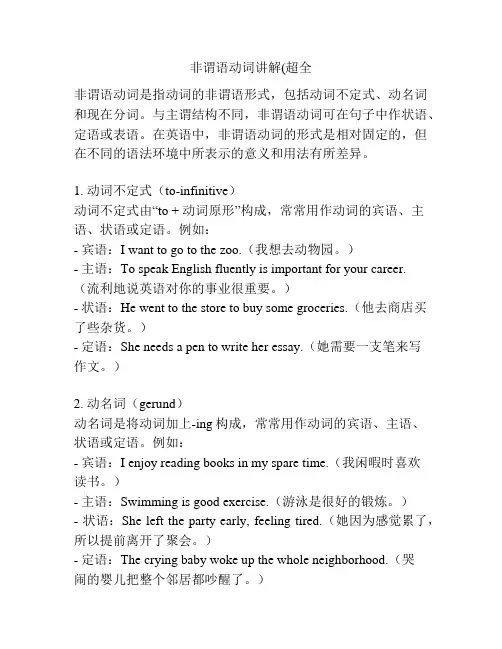非谓语动词讲解
- 格式:doc
- 大小:35.00 KB
- 文档页数:5

超详细非谓语动词讲解非谓语动词是指在句中充当动词的成分,但不具备谓语的功能,主要有动词不定式、动名词和分词三种形式。
非谓语动词可以用于句法结构、修饰成分、语态和时态等方面的变化。
下面我将分别介绍这三种形式的非谓语动词。
一、动词不定式:动词不定式是由"to + 动词原形"构成的,可以用作动词、名词、形容词和副词的成分。
动词不定式的形式有时态和语态的变化。
1. 作为动词的补充:动词不定式可以作为及物动词的宾语或介词的宾语。
例句:- I want to go to the park.(作为动词want的宾语)- She agreed to help us.(作为介词to的宾语)2. 作为名词的补充:动词不定式可以作为句子成分的一部分,并起到名词的作用。
例句:- To study is important for children.(作为主语)- My goal is to become a doctor.(作为表语)3. 作为形容词的补充:动词不定式可以修饰名词或代词。
例句:- I have a book to read.(修饰名词book)- She needs someone to help her.(修饰代词someone)4. 作为副词的补充:动词不定式可以修饰动词、形容词或副词。
例句:- He came here to visit his parents.(修饰动词came)- The coffee is too hot to drink.(修饰形容词hot)二、动名词:动名词是由动词的现在分词形式构成的名词,具有名词的特点,可以作为主语、宾语、表语、定语和同位语等。
1. 作为主语:动名词可以作为句子的主语。
例句:- Dancing is her favorite hobby.2. 作为宾语:动名词可以作为及物动词的宾语。
例句:- He enjoys swimming in the sea.3. 作为表语:动名词可以作为系动词的表语。

非谓语动词讲解(超全)非谓语动词是指动词的非限定形式,不可以独立作谓语。
它可以由动词原形、现在分词和过去分词构成,常见的形式有不定式、动名词和分词。
一、不定式:不定式是动词的一种非限定形式,常常在句中作主语、宾语、表语或定语。
它的构成方式为"to + 动词原形"。
例句:1. To learn a foreign language is not easy.(作主语)2. She wants to go shopping.(作宾语)3. The best way to learn English well is to practice every day.(作表语)4. He has a lot of work to finish.(作定语)不定式也具有进行时态、完成时态和被动语态的形式:进行时态:to be + 动词的现在分词完成时态:to have + 动词的过去分词被动语态:to be + 动词过去分词例句:1. He seems to be sleeping.(不定式进行时态)2. You should have told me earlier.(不定式完成时态)3. The car needs to be repaired.(不定式被动语态)二、动名词:动名词是指动词的-ing形式,它可以作主语、宾语、表语、定语或状语。
在句中的位置和用法与名词相似。
例句:1. Reading is my favorite hobby.(作主语)2. I enjoy swimming in the summer.(作宾语)3. Her dream is becoming a famous singer.(作表语)4. The girl standing over there is my sister.(作定语)5. He went to the party without saying goodbye.(作状语)动名词与不定式的区别在于动名词具有进行时态和被动语态,而不定式没有。


英语语法非谓语动词讲解超全超实用在英语语法中,非谓语动词是指在句子中不能独立充当谓语,而是通过与其他词语搭配来发挥作用的动词形式。
非谓语动词包括动词不定式、动名词和分词。
本文将对这三种非谓语动词进行详细的讲解,帮助读者更好地理解和运用。
一、动词不定式1.定义和形式:动词不定式是由动词原形加上"to"构成的形式,表示不完整的动作或状态。
例如:to eat, to dance。
2.用途和功能:(1)作主语:动词不定式可以作为句子的主语,常放在句首。
例如:To learn a new language is challenging.(2)作宾语:动词不定式可以作为及物动词的宾语,表示动作的目的或意图。
例如:I want to learn English.(3)作表语:动词不定式可以作为系动词的表语,表示身份、偏好、目的等。
例如:Her dream is to become a doctor.(4)作定语:动词不定式可以修饰名词或代词,起到进一步说明或限定的作用。
例如:The best way to improve English is to practice more.(5)作状语:动词不定式可以表示时间、目的、方式等状语的作用。
例如:I went to the park to relax.3.特殊用法:(1)省略to:在某些情况下,不定式的to可以省略,例如在助动词let、make、help等后面。
例如:Let me go.(2)动词不定式的时态:动词不定式没有人称和数的变化,但可以根据不同的时间来使用不同的时态。
例如:I want to go shopping.(现在时态)I wanted to go shopping.(过去时态)二、动名词1.定义和形式:动名词是由动词加上-ing构成的形式,可以作为名词使用。
例如:swimming, running。
2.用途和功能:(1)作主语:动名词可以作为句子的主语,常放在句首。






什么是非谓语动词在英语语法中,非谓语动词是一类特殊的动词形式,它不具备谓语动词的一些特征,如时态和人称的变化。
非谓语动词包括动词的不定式(infinitive)、动名词(gerund)和分词(participle)。
非谓语动词在句子中可以作为名词、形容词或副词的成分。
1. 不定式(infinitive)不定式是非谓语动词中最常见的形式之一。
它通常由动词的词根形式加上to构成,例如to go、to eat、to learn等。
不定式可以用作名词、形容词或副词。
作为名词时,不定式可以做主语、宾语、表语等。
例如:- To travel is my dream.(去旅行是我的梦想。
)- He wants to buy a new car.(他想买一辆新车。
)作为形容词时,不定式可以修饰名词,并用来表达目的、原因、结果等。
例如:- He needs a book to study.(他需要一本书来学习。
)- I am happy to see you.(我很高兴见到你。
)作为副词时,不定式用来修饰动词、形容词或副词,表示目的、结果、方式等。
例如:- She works hard to succeed.(她努力工作以获得成功。
)- He walked slowly to avoid falling.(他慢慢地走以避免摔倒。
)2. 动名词(gerund)动名词是动词的-ing形式,它可以作为一个名词在句子中使用。
与不定式不同,动名词可以作为主语、宾语、表语、介词宾语等。
例如:- Swimming is good exercise.(游泳是一项好的锻炼。
)- I enjoy singing.(我喜欢唱歌。
)动名词也可以与一些特定的动词或动词短语搭配使用,这些短语通常以动名词作为宾语。
例如:- He admitted stealing the money.(他承认偷了钱。
)- She can't help laughing.(她禁不住笑。

非谓语动词讲解(超全非谓语动词是指动词的非谓语形式,包括动词不定式、动名词和现在分词。
与主谓结构不同,非谓语动词可在句子中作状语、定语或表语。
在英语中,非谓语动词的形式是相对固定的,但在不同的语法环境中所表示的意义和用法有所差异。
1. 动词不定式(to-infinitive)动词不定式由“to + 动词原形”构成,常常用作动词的宾语、主语、状语或定语。
例如:- 宾语:I want to go to the zoo.(我想去动物园。
)- 主语:To speak English fluently is important for your career.(流利地说英语对你的事业很重要。
)- 状语:He went to the store to buy some groceries.(他去商店买了些杂货。
)- 定语:She needs a pen to write her essay.(她需要一支笔来写作文。
)2. 动名词(gerund)动名词是将动词加上-ing构成,常常用作动词的宾语、主语、状语或定语。
例如:- 宾语:I enjoy reading books in my spare time.(我闲暇时喜欢读书。
)- 主语:Swimming is good exercise.(游泳是很好的锻炼。
)- 状语:She left the party early, feeling tired.(她因为感觉累了,所以提前离开了聚会。
)- 定语:The crying baby woke up the whole neighborhood.(哭闹的婴儿把整个邻居都吵醒了。
)3. 现在分词(present participle)现在分词由动词原形加上-ing构成,常常用作动词的宾语、主语、状语或定语。
例如:- 宾语:He enjoys playing soccer on weekends.(他喜欢周末踢足球。
)- 主语:Listening to music helps me relax.(听音乐帮助我放松。
非谓语动词讲解史上最全非谓语动词是英语中的一种特殊动词形式,它们在句子中通常不具备时态和人称的变化。
非谓语动词包括不定式、动名词和现在分词。
一、不定式(Infinitive)不定式由to加动词原形构成,具有动词和名词的双重特征。
不定式在句子中可以作主语、宾语、表语、定语、状语等成分。
1. 作主语:To learn a foreign language is beneficial to your career.学习一门外语对你的事业有益。
2. 作宾语:I want to visit my grandparents this weekend.我想这周末去看望我的祖父母。
3. 作表语:His dream is to become a famous writer.他的梦想是成为一名著名的作家。
4. 作定语:She has many books to read.她有很多书要读。
5. 作状语:He came to help us.他来帮助我们。
二、动名词(Gerund)动名词由动词原形加-ing构成,具有动词和名词的双重特征。
动名词在句子中可以充当主语、宾语、表语、定语、状语等成分。
1. 作主语:Swimming is my favorite sport.游泳是我最喜欢的运动。
2. 作宾语:I enjoy reading novels in my free time.我喜欢在空闲时间读小说。
3. 作表语:Her hobby is singing.她的爱好是唱歌。
4. 作定语:The running water is clear.流动的水很清澈。
5. 作状语:She went shopping after finishing her homework.她在完成作业后去购物。
三、现在分词(Present Participle)现在分词由动词原形加-ing构成,具有动词和形容词的双重特征。
现在分词在句子中可以充当定语、表语、状语等成分。
初中英语非谓语动词讲解在初中英语的学习中,非谓语动词是一个比较重要且有一定难度的语法点。
理解和掌握非谓语动词对于提高英语语言的运用能力有着至关重要的作用。
那么,什么是非谓语动词呢?非谓语动词就是在句子中不能单独作谓语的动词形式,主要包括动词不定式、动名词和分词(现在分词和过去分词)。
我们先来看看动词不定式。
动词不定式的基本形式是“to +动词原形”,比如“to study”“to play”。
它在句子中可以作主语、宾语、定语、状语、宾语补足语等成分。
作主语时,通常把动词不定式放在句首,谓语动词用单数形式。
例如:“To learn English well is not easy”(学好英语不容易。
)不过,为了避免句子头重脚轻,常用 it 作形式主语,真正的主语动词不定式后置,比如:“It is not easy to learn English well”作宾语的情况也很常见,比如“want to do sth”(想要做某事)“decide to do sth”(决定做某事)。
作定语时,动词不定式通常放在被修饰的名词或代词后面,例如:“I have a lot of homework to do”(我有很多作业要做。
)作状语时,可以表示目的、结果等。
比如“He came here to see me”(他来这儿是为了看我。
)“He is too young to go to school”(他太小了,不能上学。
)作宾语补足语的例子有“ask sb to do sth”(让某人做某事)“tell sb to do sth”(告诉某人做某事)。
接下来是动名词。
动名词是由动词+ ing 形式构成,比如“studying”“playing”。
动名词具有名词的特征,在句中可以作主语、宾语、定语等。
作主语时,谓语动词用单数形式,例如:“Swimming is good for health”(游泳对健康有益。
非谓语动词讲解大全非谓语动词是指动词的非动词性形式,包括动词不定式、动名词和现在分词三种形式。
非谓语动词在句子中常常作为句子成分,可以作主语、宾语、定语、状语等。
1. 动词不定式动词不定式是一个非谓语动词形式,由“to”+动词原形构成。
它可以表示目的、结果、原因、条件、目标等意义。
例句:- To study hard is the key to success.(努力学习是成功的关键。
)- I want to go travelling next summer.(我想下个夏天去旅行。
)- He worked hard to earn enough money for his family.(他为了养家糊口而努力工作。
)2. 动名词动名词是一种非谓语动词形式,由动词原形加“-ing”构成。
它可以作主语、宾语、定语、状语等,并且可以与介词连用。
例句:- Swimming is good for health.(游泳对健康有好处。
)- I enjoy reading books in my free time.(我闲暇时喜欢读书。
)- She was busy preparing for the exam.(她忙着准备考试。
)3. 现在分词现在分词是一个非谓语动词形式,由动词原形加“-ing”构成。
它通常作为形容词使用,修饰名词或代词。
例句:- The burning coal produced a lot of smoke.(燃烧的煤产生了很多烟。
)- The running water sounded very pleasant.(流动的水声听起来很悦耳。
)- The crying baby needed to be fed.(哭闹的婴儿需要喂食。
)非谓语动词在句子中有很多常见的用法,以下是一些常见的用法及示例:1. 动词不定式作主语:- To travel is my dream.(旅行是我的梦想。
非谓语动词讲解以及例句非谓语动词是指动词的非谓语形式,不受主语的人称和数的限制,常用作句子的宾语、定语或状语。
非谓语动词包括动名词、不定式和分词三种形式。
一、动名词(-ing形式):1. 作主语:Being kind to others is always a good thing to do.(对他人友善总是值得做的好事。
)2. 作宾语:I enjoy swimming in the ocean.(我喜欢在海里游泳。
)3. 作宾补:She made a decision, ending their relationship.(她做出了一个决定,结束了他们的关系。
)4. 作定语:The running water is so clear and refreshing.(流动的水非常清澈和令人神清气爽。
)5. 作状语:Knowing the answer, he raised his hand.(知道答案后,他举手了。
)二、不定式(to + 动词原形):1. 作主语:To learn a new language is challenging but rewarding.(学习一门新语言是具有挑战性但值得的。
)2. 作宾语:She wants to visit Paris next year.(她想明年去巴黎旅游。
)3. 作宾补:I need to finish this report by tomorrow.(我需要明天之前完成这份报告。
)4. 作定语:He is the best person to ask for help.(他是寻求帮助的最佳人选。
)5. 作状语:She went to the library to study.(她去图书馆学习。
)三、分词:1. 现在分词(-ing形式):The crying baby woke up the entire neighborhood.(哭闹的婴儿吵醒了整个社区。
英语非谓语动词讲解及练习非谓语动词是指分词(包括现在分词和过去分词)、不定式、动名词等三种形式,即:doing , done , to do , doing 。
当然它们有各自不同的变化形式,如:现在分词 doing : 有being done(被动式); having done (完成式); having been done (完成被动式)不定式to do : 有to be done (被动式); to have done (完成式); to be doing(进行式)动名词doing : 有having done(完成式); being done(被动式);非谓语动词的特点:三种非谓语动词都具有动词的特征,虽然它们没有人称和数的变化,但是它们都能带自己的状语或有时跟宾语。
它们都有各自的特征:分词具有形容词和副词的特征;动名词具有名词的特征;不定式具有名词、形容词和副词的特征。
具体来讲:分词在句子中可以做定语、表语、状语或补足语等;动名词在句子中可以做主语、宾语、表语等;不定式在句子中可以做主语、宾语、表语、补足语或状语。
下面分别对三种非谓语动词进行讲解:一、动词不定式先看几个例句,判断不定式在句中的成分。
1.To learn a foreign language is difficult .2.His wish is to be a driver .3.Tom wanted to have a cup of beer .4.The teacher told us to do morning exercises .5.I have nothing to say .6.They went to see their aunt .7.It’s easy to see their aunt.8.I don’t know what to do next .9.I heard them make a noise .说明:1.动词不定式作主语, 2.动词不定式作表语,3.动词不定式作宾语,4.动词不定式作宾语补足语,5.动词不定式作定语,6.动词不定式作目的状语,7.动词不定式作真正主语,it 代替动词不定式,作形式主语。
8.带有连接代词的动词不定式作宾语,9.不带to 的动词不定式作宾语补足语。
掌握动词不定式应注意的几个问题:1.“to” 是不定式符号还是介词,下列短语中的to 都是介词。
agree to object to close to , come to , lead to , refer to ,equal to , familiar to , point to , thank to , devote to , next to , belong to , be used to , look forward to2.带to 还是不带toI have no choice but to give inI cannot do anything but give inI saw him enter the classroom .(但是:He was seen to enter the classroom .)3.动词不定式逻辑主语是由for 作为标记的。
但是有时用of .It’s necessary for you to study hard .It’s foolish of him to do it .与of 连用的形容词有:good, kind , nice , wise ,clever , foolish , right , wrong , careful , careless , polite , possible4.后接不定式作宾语的动词有:want , hope , wish , like , begin , try , need , forget , agree , know , promise , teach , refuse , help , arrange , dare , decide , determine , fail , manage , offer , prepare , continue , ask , mean , choose , expect etc.需要宾语补足语的动词不能用动词不定式直接做介词的宾语,而要用it做形式宾语。
例如:通常不说We think to obey the laws is important . 而说We think it important to obey the laws . 5.不定式的省略。
下列短语中,如果意义明确,常常省略到to 。
want to , wish to ,hope to , like to , hate to , plan to , try to , love to , have to , ought to , need to , used to , be able to6.不定式作定语,应注意两种关系:1)动宾关系:He has a lot of meeting to attend .Please lend me something to write with .He is looking for a room to liveHe is looking for a room to live in .He has no money and no placeto live ( in ) .I think the best way to travel ( by ) is on foot .There is no time to think ( about ) .2)主谓关系:She is always the last ( person) to speak at the meeting .----I’m going to the post office , for I have a letter to post . ( 逻辑主语是I )-------Thank you. But I have no letters to be posted now 逻辑主语不是I )7.不定式作状语,可以有以下几种意义:1)原因He is lucky to get here on time .这种结构中常用的形容词有:happy , glad , delighted , pleased , sorry , eager , anxious . lucky , fortunate , proud , angry surprised , frightened , disappointed , ready , clever , foolish , worthy2) 目的He came to help me with my maths .3) 结果I hurried to get there only to find him out .The book is too hard for the boy to read .He is old enough to go to school .8 . 不定式作补足语I saw him play in the street just now .能跟不带to 的不定式作补足语的动词有:see , feel , hear , listen to , look at , watch , let , have make, observe, notice注: 当这些词为被动式时,不定式要带to , 如:He was seen to play in the street just now.二.动名词Learning English is very difficult .学英语非常困难。
His job is driving a bus .他的工作是开车。
I enjoy dancing .我喜欢跳舞。
I have got used to living in the country .我已经习惯了住农村。
Take some sleeping tablets , and you will soon fall asleep .吃点安眠药,你很快就会入睡。
注意以下几种结构:1.There’s no telling what will happen .=It’s impossible to tell what will happen .= No one can tell what will happen .2.It’s no use talking with him .It’s no good s peaking to them like that .3.There’s some difficulty ( in ) doing …在此句型中,difficulty 可以由以下单词替换:trouble , problem , fun , pleasure , a good time , a hard time 注意以下几个问题:1.下列动词后跟不定式与跟动名词作宾语意义有区别,forget to do … 忘记要做某事forget doing…忘记做了某事remembe r to do…记住要做某事remember doing …记着做了某事mean to do …有意要做某事mean doing …意味着做了某事regret to do … 对要做的事表示后悔regret doing … 对做过去的事后悔can’t help to do…不能帮助做某事can’t help doing … 情不自禁做某事try to do …尽力去做某事try doing 试着做某事learn to do …学着去做某事learn doing …学会做某事stop to do …停下来去做(另一件事)stop doing …停止做某事go on to do …接着做(另外一件事)go on doing …继续做某事used to do …过去做某事be used to doing … 习惯做某事2.动名词作定语与现在分词作定语意义有区别动名词作定语表达n+ for doing 的含义现在分词作定语表达 n+which(who) be doing的含义如:a sleeping car = a car for sleepinga running horse = a horse which is running前者是动名词,后者是现在分词又如:drinking water , walking stick running water , sleeping boy3.动名词的逻辑主语:动名词的逻辑主语为代词或名词的所有格形式。